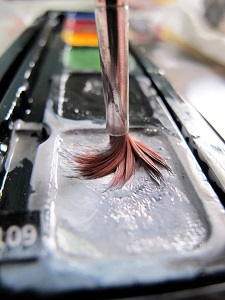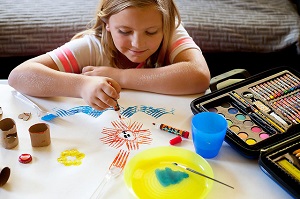
If you want to see sheer, unadulterated freedom of artistic expression, observe a three year old with a box of crayons and a blank piece of paper.
We come by those early surges of creativity naturally. Human beings have been painting, sculpting, and creating complex works of art for at least 17,000 years and we’ve been making music even longer.
Art was part of our lives when we dwelled in caves. It has lasted through feast and famine, in war and in peace, and through the ravages of time. It exists in countless forms and in every culture on Earth.
Why is art so enduring? It’s speaks to our desire to understand and to be understood.
“I believe the role of an artist throughout history, whether it be as a painter, writer, musician, or other is to provide rich commentary on the complexities of the human experience,” commented Jude Harzer, a painter, educator, and art advocate.
“Simply put,” she continued, “we serve as witnesses and recorders of life, whether it be of the internal life: consciousness, emotions, thought, spirituality, and so forth or of the external life: historical, political, social, cultural or familial.”
Most of us struggle to make sense of our place in the grand scheme of things. Art is a vehicle to help us translate the human experience into a universal language.
“A song, a novel, a sculpture have the power to preserve and communicate what moves us as human beings, tugging at our core and enlivening our spirit,” Jude explained.

We’ve slowly built a culture of busyness for busyness sake and technology that fills every conceivable gap in our days. We’re pretty good at passively soaking in information. We’re not so good at tapping our own fertile imaginations or allowing time for quiet reflection.
“The ritual of making art, much like a meditative practice, allows me to quiet my thoughts and to order my entire sense of being,” said Jude. “A shedding of the clutter and ‘noise’ of life happenings inevitably occurs. It’s a mental and spiritual cleansing of sorts, a digesting of human experience that, hopefully, results in the creation of something of value.”
Art provides us with the gift of time. For the artist, time to harness fragmented ideas and make them whole. For the beholder, time to contemplate life’s pleasures, pains, and eternal mysteries.
Studies show that viewing art triggers a surge of dopamine, the “feel good” chemical in the brain, and positively affects historical empathy and tolerance.
Of course, art is subjective. We don’t all see the same thing when we view a colorful landscape, a melancholy sketch, or an abstract sculpture. But what’s more intriguing is that our own perspective of a single piece of art can change over time.
Our individual and collective past, present, and future co-exist within the arts. If we’re open to it, art can free us to think beyond the daily details of our lives.
“Art washes away from the soul the dust of everyday life.” — Pablo Picasso
If you appreciate art, you probably already know that as it affects your state of mind, it also affects your body. Art can promote physical well-being, a phenomenon observed by researchers.
Studies have linked positive emotions, especially the awe of nature, art, and spirituality, with a reduction in pro-inflammatory cytokines and a stronger immune system. Even a quick visit to an art gallery during your lunch hour has been shown to positively influence stress levels. Researchers have found that hospital patients who view art suffer less and recover faster.
Professional art therapists help their patients enhance their self-esteem, improve emotional resilience, and resolve conflicts and distress. Art therapy is also used to improve cognitive and sensory motor functions.
Art taps into the mind-body connection.
What is art?
Perhaps a haunting melody is the tonic that soothes your soul. Or maybe you never feel so at home as when you’re in front of the pottery wheel. Dancing. Quilting. Sketching. Acting. Photography. Architecture.
Maybe you feel compelled to journal those abstract thoughts that wake you in the middle of the night. Journaling has long been used to help people deal with stress and trauma. Research suggests that expressive writing, like the other arts, may also provide some physical benefits.
As an artist, Jude considers her work to be an extension of who she is as an individual. But sharing her personal story is a stepping stone to broader connections.
“Innately, I have a strong need to make work in response to that which haunts, distresses, or inspires me,” she said. “I value the opportunity to observe, reflect upon, and document my story hoping that it will resonate with others and mirror their experiences as well. Art in a sense provides affirmation that we are not alone, that we are understood.”
Art is connectedness. Art is soul dusting.
Article by Ann Pietrangelo
Photos by A Watercolor Palate by Erin Derby; Personal Creations by PersonalCreations.com